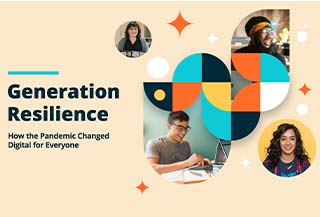

Generation Rebuild: Digital Habits Are Forever Changed
“Generational Resilience” is the fourth annual study commissioned by WP Engine and conducted by The Center for Generational Kinetics (CGK). The study examines new and prevailing expectations for digital held by different generations of web users and provides insights into the evolving digital preferences of savvy online audiences and consumers across all generations for marketers, strategists, and business leaders across every industry.
While this year’s research continues the previous years’ focus on younger generations like Millennials and Gen Z, it also offers additional detail on the digital behaviors of other generations, including Baby Boomers and Gen Xers, for a wider look at the way every generation has responded to and changed alongside the Covid-19 pandemic.
We hope these key insights identifying behaviors and digital preferences of all generations will arm you with actionable information that provides clarity in your technology decisions today and ultimately, your digital strategy for the future.
Download the ebook or keep reading for an excerpt of the full report
Rebuild: Digital Habits Are Forever Changed
Just as digital connections fueled resilience throughout the pandemic, they’ve also served as the tools each generation has used as they begin rebuilding—in their careers, their education, or their connection with others.
Digital channels have allowed each generation to transition from the initial, reactive state of resilience, and transition into a more proactive stance for rebuilding, in both their personal and professional lives.
From Digital Trends to Daily Habits
While every generation used the web for a litany of first-time activities during the pandemic, they also adopted these outlets as mainstays of their new daily routines.
While every generation relied on the web for first-time activities due to widespread physical constraints, many respondents expressed the desire to continue their use of the digital channels they adopted or increasingly turned to during the pandemic.
Large majorities of Millennials (68%) and Gen Z (57%) said they expected to maintain their digital habits going forward, as so much online activity is now woven seamlessly into their daily lives.
This widespread confidence among younger generations is a notable indicator of something we already intrinsically knew: the tide of digital acceleration that came in with the pandemic is not turning back.
The convenience and safety that digital channels provide have unlocked a new level of expectation that now sits squarely alongside the physical domain. Outside of an unforeseen Luddite revolution, there’s little reason to believe it will change course.
Digital money transfer, for example, through platforms like Venmo and Cash App, has rendered waiting in line at the bank mostly unnecessary. Digital money apps saw usage skyrocket during the pandemic, with much of that activity continuing to grow. Indeed, more than a third (34%) of Gen Z respondents said they planned to continue their use of digital money transfer specifically, which 28% tried for the first time in 2020.
On the other side of the generational divide, Baby Boomers, who have historically been the most reluctant generation to adopt new technology, have embraced digital medicine, with more than a quarter of respondents over the age of 56 expressing the desire to continue with the convenience and safety of telehealth rather than return to in-person doctor’s appointments.
In all, the ubiquitous nature of digital channels for activities that appeal to every generation has led them all to embrace these channels when and where it’s most convenient for them.
The eCommerce Boom
That widespread embrace is perhaps most apparent in the surging world of eCommerce, which is set to become a trillion-dollar market by 2022.
U.S. eCommerce sales grew 44% in 2020, and this rapid increase in online shoppers has meant higher revenues for many businesses.
At the same time, it’s also made the landscape more competitive, as eCommerce is among the top online activities that are centered around convenience. Today, eCommerce sites with subpar performance and a poor user experience can no longer compete with fast-loading, easy-to-use, more visually appealing alternatives.
Younger generations have long been the audience eCommerce sites are competing for, and they’ve had a major influence on the strategies and best practices some of the largest eCommerce sites have employed with success.
Beyond faster page speeds and easier navigation, Gen Z’s digital preferences have played a key role in bringing deeper personalization, simplicity, and authenticity to the web in general as well as eCommerce sites specifically.
But even as Gen Z and Millennials continue to push the limits of technology, eCommerce strategies may actually be well-advised to take a cue from Baby Boomers, who have increasingly engaged in eCommerce activity during the pandemic with a healthy dose of frustration.
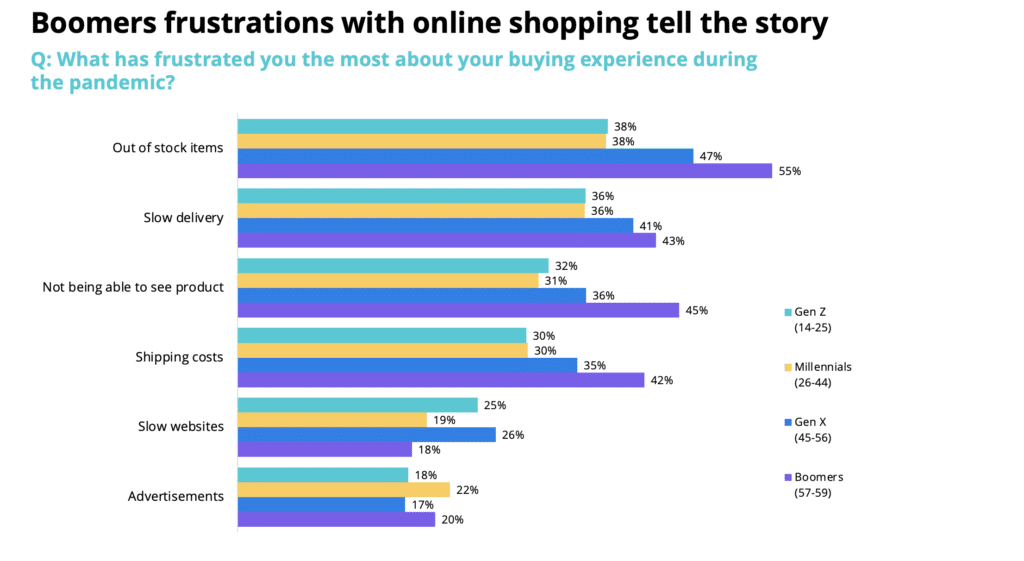
While irritation with product visibility, slow websites, and advertisements are shared across the generations, Baby Boomers offer a line of sight into the larger challenges faced by businesses that rely on eCommerce.
As seen in the chart above, many of their eCommerce frustrations occur away from the website itself—out-of-stock items, slow delivery, and shipping costs. However, these frustrations underscore the importance of businesses incorporating this information and offering real transparency within the online shopping experience.
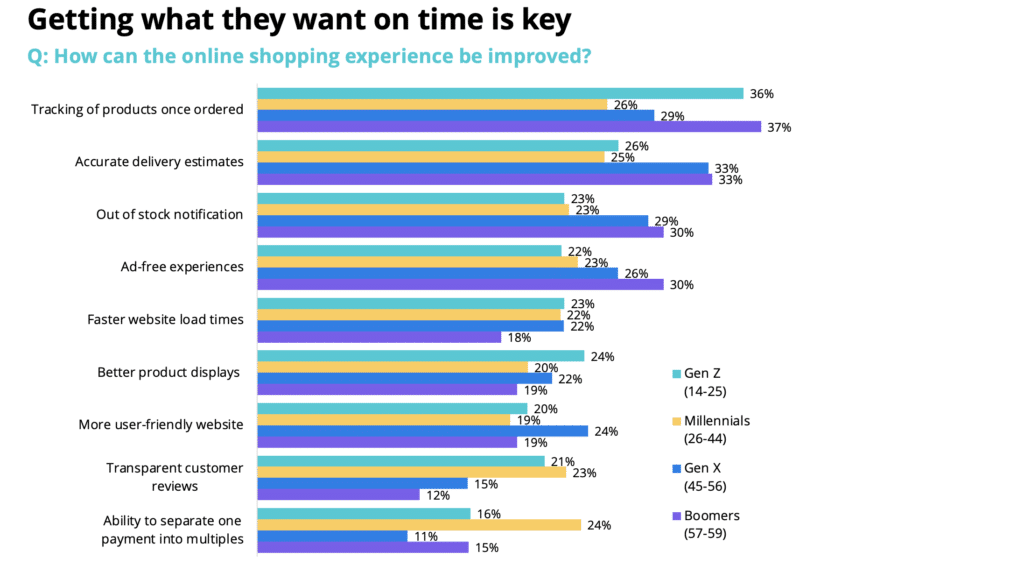
While eCommerce will undoubtedly play a dominant role for years to come, there’s less of a consensus when it comes to the strategies and types of websites needed to reach online consumers across all generations with engaging digital experiences that provide them with exactly what they’re looking for, fast.
Thinking about your target customer demographics and incorporating some of the generational-specific feedback into your eCommerce stores will imbue your overall shopping experience with precisely the features and functionality your consumers want.
Carrying America’s Social Conscience
In a continuation of data from previous years, Gen Z remains at the forefront when it comes to forging a connection between companies and the social causes they support.
37% of Gen Z and 25% of Millennials said they get information about a company’s involvement with social causes from social media specifically.
While this may come as little surprise given younger generations’ heavy social media activity, it is notable as businesses rebuild from the pandemic, widen their social reach, and forge connections with specific social causes.
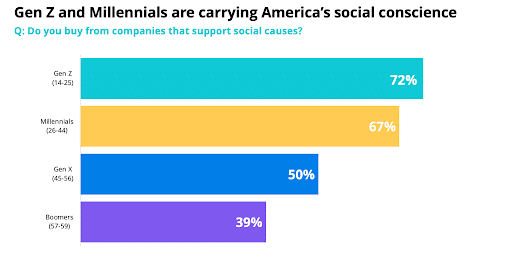
As they do, younger generations will be paying close attention, rewarding companies that take a stand on the issues they align with and dismissing those that don’t.
Reimagining the Classroom and the Workplace
A final, if seemingly obvious area where each generation has harnessed digital channels to rebuild from the pandemic has been across the daily routines of work or school.
For younger generations, education has been forever changed, with in-person learning suspended for indefinite periods of time and virtual learning jumping in to fill the gap.
While it certainly has its detractors, virtual learning has served a vital role in allowing younger generations to continue their education, even at the height of the pandemic. In fact, a majority of Millennials (57%) and nearly half of Gen Z (45%) said they found virtual learning to be more conducive to their education than in-person classes. Meanwhile, older generations had a far lower opinion of virtual learning, with 35% of Gen X and 19% of Baby Boomers viewing it as effective.
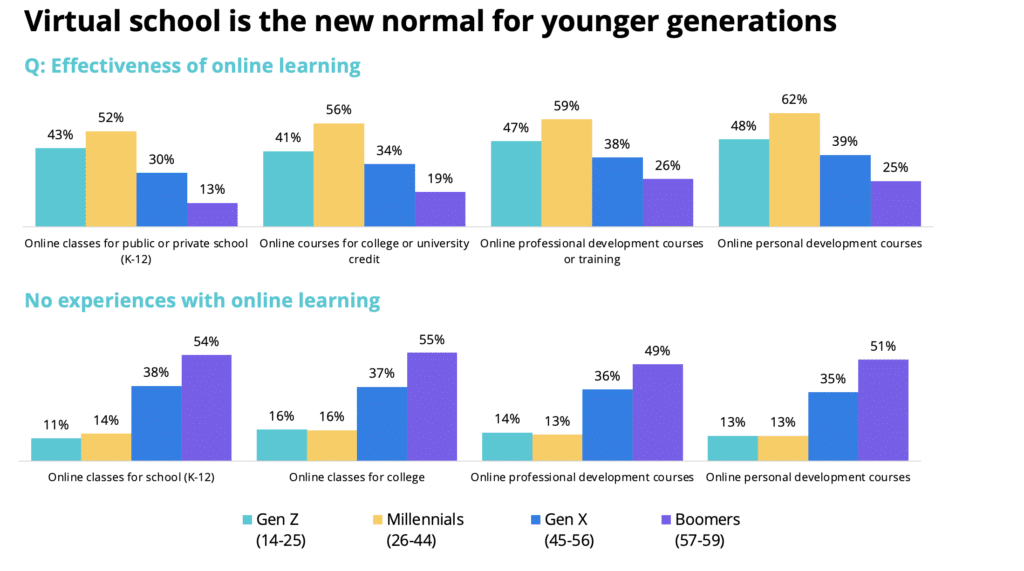
A similar dynamic has played out in the workplace, where the majority of respondents said they found remote work favorable to a full-time return to the office. 48% of Gen Z, 65% of Millennials, and 54% of Gen X would prefer to continue working remotely indefinitely, while Baby Boomers, many of whom are retired, tracked lower at 30%.
While burnout and fatigue were expected sentiments when gauging work-life balance during the pandemic, a surprising 49% of Gen Z and 59% of Millennials said their work-life balance had actually improved.
That said, 49% of Millennials said remote work had stunted their careers, due in no small part to the loss of physical, in-person connection that’s inherent in the virtual workplace.
As each generation has rebuilt personal and professional connections throughout the pandemic, there are clear trends and more complex nuances that have emerged across each age group. What’s clear is that every generation has leveraged digital channels to their advantage, making the best of situations that might have otherwise been far more isolating or detrimental to personal or professional growth.
As each generation has put one foot in front of the next, they’ve not only rebuilt their own realities within the new digital paradigm, many of them are rising higher than ever before, as they shape the digital landscape ahead of them.
Fuel the freedom to create with WP Engine
WP Engine powers the freedom to create on WordPress. The company’s products, the fastest among all WordPress providers, power 1.5 million digital experiences. More of the top 200,000 sites in the world use WP Engine to power their digital experiences than anyone else in WordPress.
About WP Engine
WP Engine, the WordPress technology company, provides the most relied upon and trusted brands and developer-centric WordPress products for companies and agencies of all sizes, including managed WordPress hosting, enterprise WordPress hosting, headless WordPress, Flywheel, Local, and Genesis. WP Engine’s tech innovation and award-winning WordPress experts help to power more than 1.5 million sites across 150 countries.
Read the full report to find out more!











